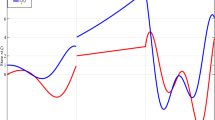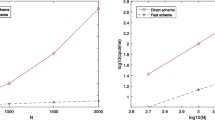Abstract
This paper is concerned with the numerical stability of time fractional delay differential equations (F-DDEs) based on Grünwald–Letnikov (GL) approximation for the Caputo fractional derivative. In particular, we focus on the numerical stability region and the Mittag–Leffler stability. Using the boundary locus technique, we first derive the exact expression of the numerical stability region in the parameter plane, and show that the fractional backward Euler scheme is not \(\tau (0)\)-stable, which is different from the backward Euler scheme for integer DDE models. Secondly, we prove the numerical Mittag–Leffler stability for the numerical solutions provided that the parameters fall into the numerical stability region, by employing the singularity analysis of generating function. Our results show that the numerical solutions of F-DDEs are completely different from the classical integer order DDEs, both in terms of \(\tau (0)\)-stability and the long-time decay rate. Numerical examples are given to confirm the theoretical results.






Similar content being viewed by others

Notes
The linear multistep method (LMM) with generating polynomials \(\rho (\zeta )\) and \(\sigma (\zeta )\) applying to the test equation gives the characteristic equation \(\rho (\zeta )-\mu \sigma (\zeta )=0\), where \(\mu =h\lambda \). For backward Euler method, we have \(\rho (\zeta )=\zeta -1\) and \(\sigma (\zeta )=\zeta \). The numerical stability region \(S_{h}=\{\mu \in \mathbb {C}: \text { all roots }\zeta _j(\mu ) \text { of the characteristic equation satisfy }|\zeta _j(\mu )|<1\}.\) Sometimes one defines \(S_{h}=\{\mu \in \mathbb {C}: \text { all roots }\zeta _j(\mu ) \text { of the characteristic equation satisfy }|\zeta _j(\mu )|\le 1, \text { multiple roots satisfy } |\zeta _j(\mu )|< 1\}\), which is generally called the weak linear stability region. The LMM is called A-stable if \(S_h \supset S_{*}\), i.e., \(S_h \supset \mathbb {C}^{-}\). See more details in [16, Chapter V].
References
Bellen, A., Zennaro, M.: Numerical Methods for Delay Differential Equations. Oxford University Press (2013)
Brunner, H.: Volterra Integral Equations: An Introduction to Theory and Applications, vol. 30. Cambridge University Press (2017)
Bu, S.: Well-posedness of vector-valued fractional differential equations with delay. Sci. Sin. Math. 49, 1–10 (2019)
Burov, S., Barkai, E.: Fractional Langevin equation: overdamped, underdamped, and critical behaviors. Phys. Rev. E 78(3), 031112 (2008)
Čermák, J., Došlá, Z., Kisela, T.: Fractional differential equations with a constant delay: stability and asymptotics of solutions. Appl. Math. Comput. 298, 336–350 (2017)
Čermák, J., Horníček, J., Kisela, T.: Stability regions for fractional differential systems with a time delay. Commun. Nonlinear Sci. Numer. Simul. 31(1–3), 108–123 (2016)
Čermák, J., Nechvátal, L.: On exact and discretized stability of a linear fractional delay differential equation. Appl. Math. Lett. 105, 106296 (2020)
Chen, H., Stynes, M.: Blow-up of error estimates in time-fractional initial-boundary value problems. IMA J. Numer. Anal. 41(2), 974–997 (2021)
Chen, Z.Q.: Time fractional equations and probabilistic representation. Chaos Solitons Fractals 102, 168–174 (2017)
Dabiri, A., Butcher, E.: Numerical solution of multi-order fractional differential equations with multiple delays via spectral collocation methods. Appl. Math. Mod. 56, 424–448 (2018)
Diethelm, K.: The Analysis of Fractional Differential Equations: An Application-Oriented Exposition Using Differential Operators of Caputo Type. Springer (2010)
Flajolet, P., Odlyzko, A.: Singularity analysis of generating functions. SIAM J. Discret. Math. 3(2), 240–261 (1990)
Flajolet, P., Sedgewick, R.: Analytic Combinatorics. Cambridge University Press (2009)
Garrappa, R., Kaslik, E.: On initial conditions for fractional delay differential equations. Commun. Nonlinear Sci. Numer. Simul. 90, 105359 (2020)
Guglielmi, N.: Delay dependent stability regions of \(\theta \)-methods for delay differential equations. IMA J. Numer. Anal. 18(3), 399–418 (1998)
Hairer, E., Wanner, G.: Solving Ordinary Differential Equations II Stiff and Differential-Algebraic Problems. Sciencep, Beijing (2006)
Huang, C., Hu, Y., Tian, H.: Delay-dependent stability analysis of multistep methods for delay differential equations. Acta Math. Appl. Sin. Engl. Ser. 25(4), 607–616 (2009)
Kaslik, E., Sivasundaram, S.: Analytical and numerical methods for the stability analysis of linear fractional delay differential equations. J. Comput. Appl. Math. 236(16), 4027–4041 (2012)
Kou, S.C.: Stochastic modeling in nanoscale biophysics: subdiffusion within proteins. Ann. Appl. Stat. 2(2), 501–535 (2008)
Lahrouz, A., Hajjami, R., El Jarroudi, M., Settati, A.: Mittag–leffler stability and bifurcation of a nonlinear fractional model with relapse. J. Comput. Appl. Math. 386, 113247 (2021)
Li, L., Liu, J.-G.: A generalized definition of Caputo derivatives and its application to fractional ODEs. SIAM J. Math. Anal. 50(3), 2867–2900 (2018)
Li, L., Liu, J.-G.: Some compactness criteria for weak solutions of time fractional PDEs. SIAM J. Math. Anal. 50(4), 3963–3995 (2018)
Li, L., Liu, J.-G., Lu, J.: Fractional stochastic differential equations satisfying fluctuation-dissipation theorem. J. Stat. Phys. 169(2), 316–339 (2017)
Li, L., Wang, D.: Complete monotonicity-preserving numerical methods for time fractional ODEs. Commun. Math. Sci. 19(5), 1301–1336 (2021)
Lubich, C.: A stability analysis of convolution quadraturea for Abel–Volterra integral equations. IMA J. Numer. Anal. 6(1), 87–101 (1986)
Maleki, M., Davari, A.: Fractional retarded differential equations and their numerical solution via a multistep collocation method. Appl. Numer. Math. 143, 203–222 (2019)
Matignon, D.: Stability results for fractional differential equations with applications to control processing. Comput. Eng. Syst. Appl. 2(1), 963–968 (1996)
Metzler, R., Klafter, J.: The random walk’s guide to anomalous diffusion: a fractional dynamics approach. Phys. Rep. 339(1), 1–77 (2000)
Tuan, H., Siegmund, S.: Stability of scalar nonlinear fractional differential equations with linearly dominated delay. Fract. Calc. Appl. Anal. 23(1), 250–267 (2020)
Tuan, H., Trinh, H.: A qualitative theory of time delay nonlinear fractional-order systems. SIAM J. Control Optim. 58(3), 1491–1518 (2020)
Wang, D., Xiao, A., Liu, H.: Dissipativity and stability analysis for fractional functional differential equations. Fract. Calc. Appl. Anal. 18(6), 1399–1422 (2015)
Wang, D., Zou, J.: Dissipativity and contractivity analysis for fractional functional differential equations and their numerical approximations. SIAM J. Numer. Anal. 57(3), 1445–1470 (2019)
Wang, D., Zou, J.: Mittag–leffler stability of numerical solutions for fractional ODEs. arXiv preprint arXiv:2108.09620 (2021)
Widder, D.V.: The Laplace Transform. Princeton University Press (1941)
Zayernouri, M., Cao, W., Zhang, Z., Karniadakis, G.: Spectral and discontinuous spectral element methods for fractional delay equations. SIAM J. Sci. Comput. 36(6), B904–B929 (2014)
Zhang, Q., Li, T.: Asymptotic stability of compact and linear \(\theta \)-methods for space fractional delay generalized diffusion equation. J. Sci. Comput. 81(3), 2413–2446 (2019)
Zhao, J., Jiang, X., Xu, Y.: Generalized adams method for solving fractional delay differential equations. Math. Comput. Simul. 180, 401–419
Acknowledgements
The authors would like to thank two anonymous referees for their very careful reading and insightful comments that have helped us improve the presentation of the paper significantly. The work of L. Li was partially supported by NSFC 11901389, 12031013, Shanghai Sailing Program 19YF1421300. The work of D. L. Wang was partially supported by NSFC 11871057, 11931013, 12071403.
Author information
Authors and Affiliations
Corresponding author
Additional information
Communicated by Mihaly Kovacs.
Publisher's Note
Springer Nature remains neutral with regard to jurisdictional claims in published maps and institutional affiliations.
Appendices
Proof of Lemma 4.1
Proof of Lemma 4.1
For (i), we need to show that
by Lemma 2.2. This is equivalent to
When \(\frac{(1-\alpha )\pi }{2}>1\), the inequality clearly holds. If \(\frac{(1-\alpha )\pi }{2}\in (0, 1]\), then
(ii). By Lemma 2.2, we only need to show that the straight lines are below the boundary,
It suffices to show that
It’s worth noting that the function \(h_1(x)= \frac{\sin x}{x}\) is decreasing with \(\frac{2}{\pi }\le h_1(x)\le 1\) and it is concave on \([0, \pi /2]\) (note that the sign of the second order derivative is determined by the sign of \((1-\frac{x^2}{2})\frac{\sin x}{x}-\cos x\), which is negative for \(x\in [0, \pi /2]\)).
For \(k\ge 5\), since \(\sin (\pi (1-\alpha )/2)\ge \frac{\pi }{2}(1-\alpha )\frac{2}{\pi }\), it suffices to show that
The latter is equivalent to show that (setting \(\beta =1-\alpha \)) \(h_2(\beta )=\beta \log \beta -(1-\beta )\log \left( \frac{\pi }{2k} \right) \ge 0.\) The derivative \(h'_2(\beta )\) is negative for \(k\ge 5\) and the value at \(\beta =1\) is zero. Hence, the inequality (A.2) holds for \(k\ge 5\).
If \(k=3\), consider directly (setting \(\beta =1-\alpha \)) that \( g(\beta ):=\log \left( \sin (\frac{\pi }{2}\beta ) \right) +(\beta -1)\log \left( \frac{\beta \pi }{6}\right) . \) As \(\beta \rightarrow 1^-\), \(g(\beta )\) tends to 0. Hence, to show \(g(\beta )>0\) for \(\beta \in (0,1)\), we only need to show that the first order derivative
is always negative on \(\beta \in (0, 1)\).
It is easy to see that \(g'(\beta )<0\) for \(\beta \in (0.8, 1)\) (considering only the first two terms). On the other hand, we have \( g''(\beta )=\beta ^{-1}+\beta ^{-2}-(\pi /2)^2\frac{1}{\sin ^2(\pi \beta /2)}. \) This equation \(g''(\beta )=0\) only has one root \(\beta _*\) with \(\beta \in (0, 1)\) and the root satisfies \( \frac{\sin (\pi \beta _*/2)}{(\pi \beta _*/2)}=\frac{1}{\sqrt{1+\beta _*}}. \) This can be seen from the fact \(h_1(x)=\frac{\sin x}{x}\) is decreasing and concave while the function \(\frac{1}{\sqrt{1+x}}\) is convex on \([0, \pi /2]\). At the same time, we can check \(g''(0.8)>0\) and \(g''(1)<0\). Hence, we know that the root \(\beta _*\in (0.8, 1)\) and \(g''(\beta )\) is positive on [0, 0.8]. Together with \(g'(0.8)<0\), we find that \(g'(\beta )\) is negative on (0, 0.8]. Then the first derivative is always negative on \(\beta \in (0, 1)\). Therefore, \(k=3\) is also proved. \(\square \)
Proof for the properties of the \(\Gamma _0\) curve
Proof of Lemma 4.3
Define \(\phi =\theta /2\in \left( \frac{(1-\alpha )\pi }{2(1-\alpha /k)}, \frac{\pi }{2} \right) \). Consider that
To show this function is decreasing, it is sufficient to prove that
Separate the middle term on the left side of the above equation and use the trigonometric function formula, the above equation can be equivalent to \( \frac{\alpha }{k}\frac{\sin (\phi +\alpha \pi /2-\alpha \phi /k-\phi /k)}{\sin (\phi /k)\sin (\phi +\alpha \pi /2-\alpha \phi /k)} -\frac{\sin (\alpha \pi /2-\alpha \phi /k)}{\sin (\phi )\sin (\phi +\alpha \pi /2-\alpha \phi /k)}\le 0. \) Noting that \(\sin (\phi +\alpha \pi /2-\alpha \phi /k)>0\) under the assumption \(\phi \in \left( \frac{(1-\alpha )\pi }{2(1-\alpha /k)}, \frac{\pi }{2} \right) \). Hence, we need
We are going to prove that (B.2) is true for \(k\ge 2\). Since
where the second inequality is due to the fact \(\frac{\alpha }{\sin (\alpha \pi /2-\alpha \phi /k)}\) is increasing function for \(\alpha \in (0, 1)\). By the concavity of \(\sin (x)\) on \(x\in (0, \pi /2)\), we know that \( \sin (\phi )\le \frac{k}{2}\sin (2\phi /k ) \) is true for \(k\ge 2\), which implies that \( \frac{1}{\cos (\phi /k)}\le \frac{k\sin (\phi /k)}{\sin (\phi )}. \) This together with (B.3) shows that the inequality (B.2) is true for \(k\ge 2\). This completes the first part of the proof.
Using the above fact, to show that the line is below \(\Gamma _0\), we only have to show that \(\left( a_k^{(0)},-a_k^{(0)} \right) \) is above the line, where \(a_k^{(0)}\) is defined in Lemma 4.2. In other words, we need
Since the right hand side is decreasing in \(\phi \), the largest value is achieved at \(\phi _1=0\), which is \(2^{\alpha }k^{\alpha }\). Hence, the inequality (B.4) is true. \(\square \)
Rights and permissions
About this article
Cite this article
Li, L., Wang, D. Numerical stability of Grünwald–Letnikov method for time fractional delay differential equations. Bit Numer Math 62, 995–1027 (2022). https://doi.org/10.1007/s10543-021-00900-0
Received:
Accepted:
Published:
Issue Date:
DOI: https://doi.org/10.1007/s10543-021-00900-0



